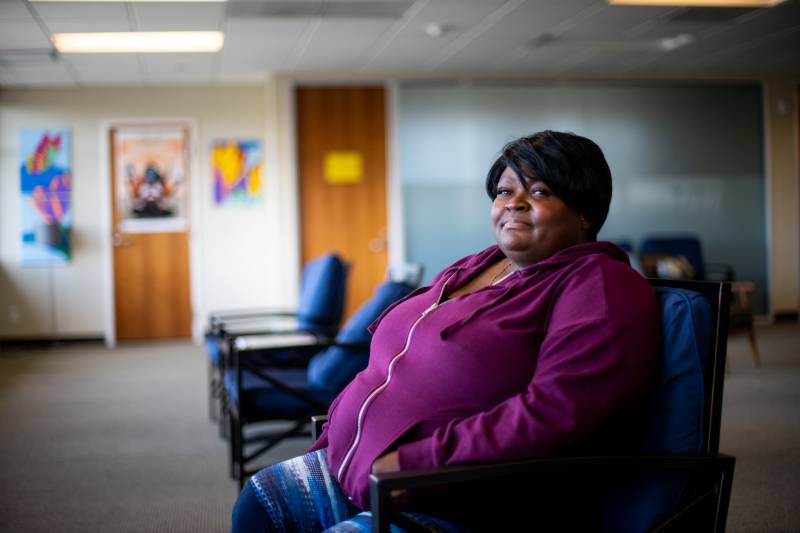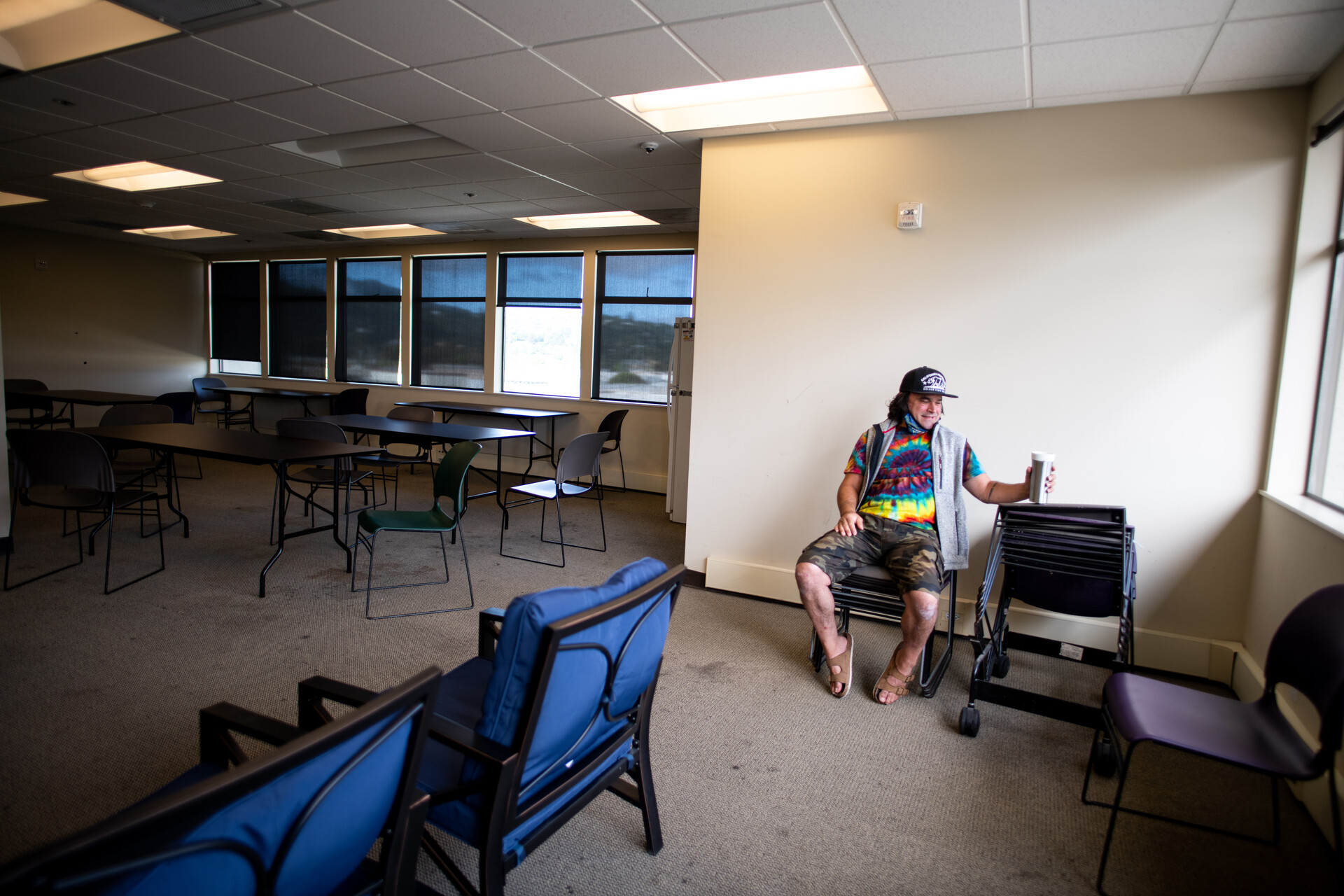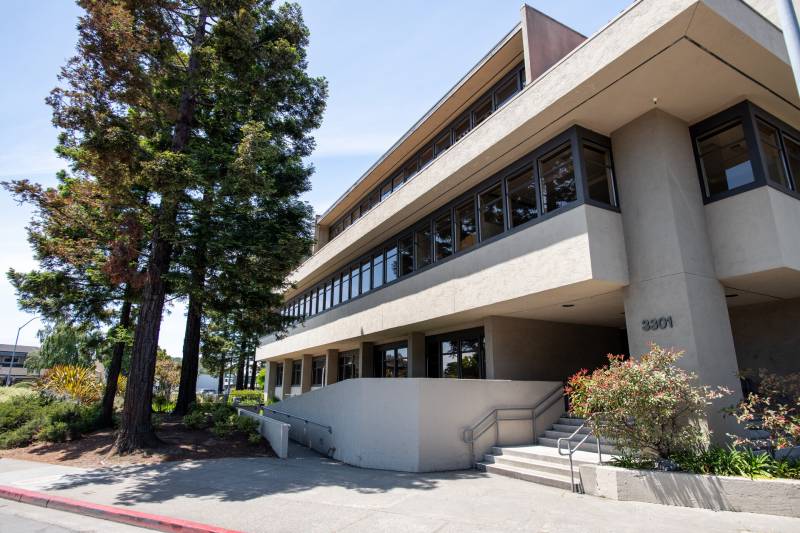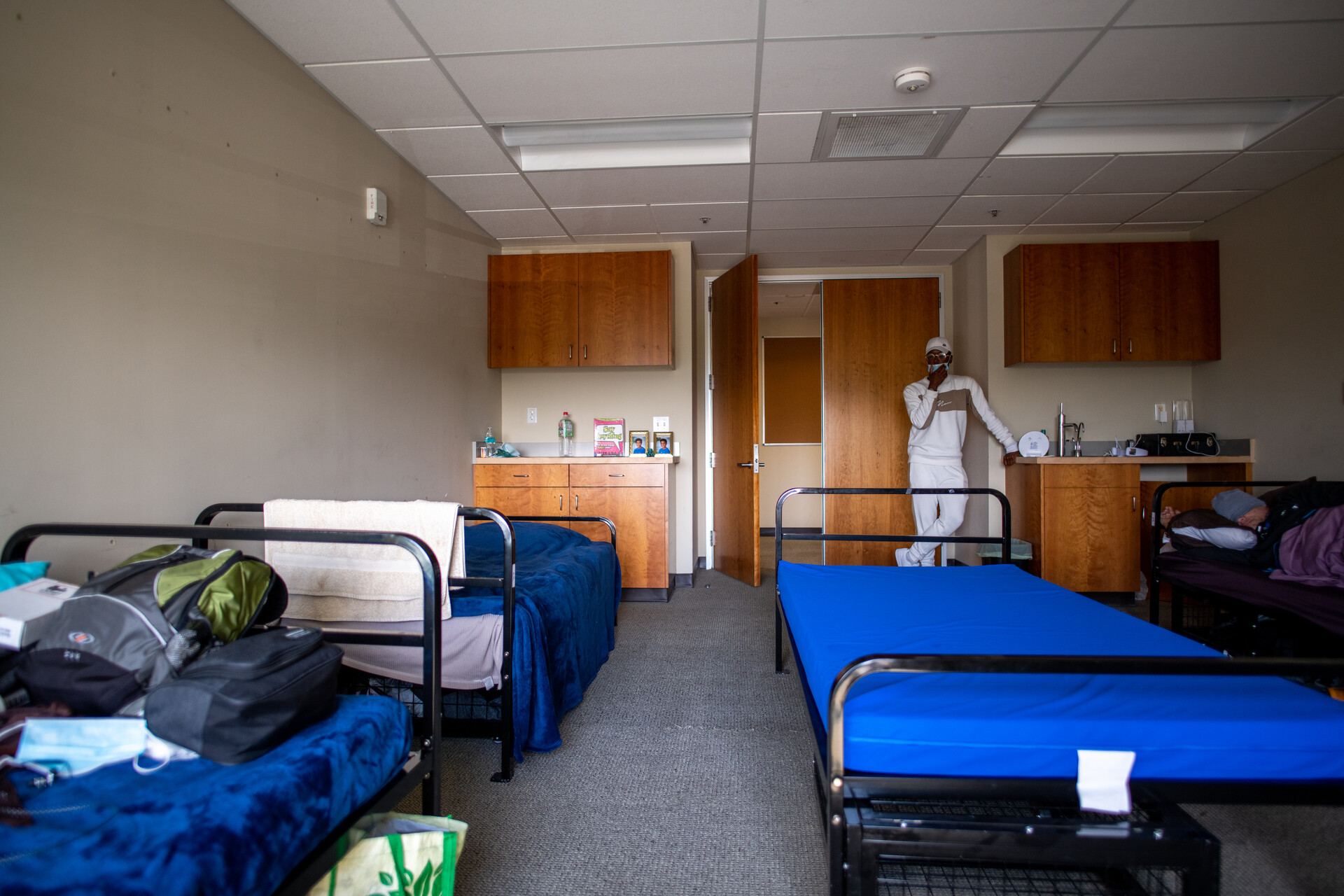Posted on: June 10, 2021
Source: KQED; Author: Erin Baldassari

Letta “Oneka” Glover sits in a common area of an office building in San Rafael that is converted into a temporary shelter for people experiencing homelessness on May 17, 2021. (Beth LaBerge/KQED)
When Letta “Oneka” Glover checked into the shelter in San Rafael, she was exhausted.
She’s 50 and has bad knees, a condition made worse by sleeping in her car. That’s where she was living in February when she heard about the new shelter on Kerner Boulevard. She moved in a week later.
“It was relief,” Glover said. “I felt like I could kind of let my shoulders down, you know, and not have to be so on guard about everything.”
This shelter isn’t like others, where she’s stayed. It’s tucked into the third floor of an office building that was once home to a legal services company. But instead of desks and chairs inside the offices, there are cots. The old lobby is now a shared work space, with computers for residents to search for jobs and housing. Large windows line a common room, with views of Mount Tamalpais.
Usually, temporary shelters are built in factories or warehouses, said Paul Fordham, deputy executive director of Homeward Bound of Marin, which is operating the shelter until it can be converted into permanent housing.
“But there’s so much light here,” he said. “It’s a very dignified, nice space to rebuild your life.”
The site is one of 94 projects funded through Homekey, a statewide program that’s created nearly 6,000 new units of housing. While the majority are hotel and motel conversions, they also include tiny homes and former vacation rentals, a college dormitory and single-family houses.
Though Homekey is barely a year old, Gov. Gavin Newsom is proposing a massive $7 billion, 46,000-unit expansion of the program. Half of the funding would be dedicated to housing for people with acute behavioral and mental health needs. It’s all part of his $12 billion proposal to combat homelessness over the next two years.
Policy experts, service providers and others who work on homelessness in California have lauded Homekey as a monumental step in creating desperately needed new subsidized housing for the state’s more than 161,000 homeless residents. But they’re only cautiously optimistic about its future.
Many of the projects will need additional money to convert to permanent housing, and they’ll also need ongoing funding to pay for services that are often critical for keeping people housed.
“It’s a great concept,” said Ellen Hammerle, Catholic Charities’ chief programs officer. “My concern is that we need to sustain it.”
And, this new housing will need to produce a visible reduction in chronic homelessness, said Andrew Hening, co-founder of the nonprofit Opening Doors Marin. It’s an issue voters say is one of their top concerns.
“From the public’s perception of this issue, if we don’t solve chronic homelessness, then it’s going to feel like nothing has been accomplished,” Hening said.
A ‘Herculean’ Task
The idea of converting existing buildings into housing for people experiencing homelessness had been bandied about for years, said Jason Elliott, Newsom’s senior counselor on housing. But it had never been tried at this scale.
When the coronavirus pandemic hit California, Newsom’s administration first launched Project Roomkey, an effort to temporarily house some 23,000 homeless seniors and medically vulnerable people in hotels and motels across the state.
But where would they all go once those hotels close? Homekey was one answer.
“So the question is,” Elliott said, “how do you get housing open as quickly and cost effectively as possible?”
Homekey launched in June 2020. To pay for it, the state relied on $750 million in federal CARES Act funding and nearly $100 million in state general funds and philanthropic donations. The federal money, however, had to be spent by the end of 2020.
That meant cities and counties had to identify and evaluate sites, find service providers and development partners, get the projects approved and close escrow — all within a matter of months.

Chris Parra sits in a communal dining area in a former office building in San Rafael that was recently converted into a temporary shelter for people experiencing homelessness. (Beth LaBerge/KQED)
The timeline was “Herculean,” said Ashley Hart McIntyre, Marin County’s homelessness policy analyst. But it also helped the projects quickly clear hurdles that typically take years to overcome: The state Legislature waived some environmental reviews to speed projects along, and there was less time for community opposition.
Already, the program has become a national model, said Diane Yentel, the president and CEO of the National Low Income Housing Coalition. In the latest round of federal stimulus, approved in March, Congress allocated $5 billion for states to create new affordable housing, including hotel and motel conversions.
“I don’t think we would have been able to be successful in getting Congress to put that $5 billion forward for this purpose if we hadn’t had states like California take that first step,” Yentel said.
Many city and county officials also say Homekey helped overcome some of the bureaucracy that’s come to define California’s disjointed approach to addressing homelessness. A scathing audit published earlier this year found there are nine state agencies administering 41 separate programs.
Mike Walsh, deputy director at the Riverside County Housing Authority, said his agency was able to apply to one large pot of money that was then used for multiple projects, including one for LGBTQ+ youth in downtown Riverside and another for immigrant farmworker communities in Oasis, Mecca and Thermal. To him, that was a big deal.
“It really allows us to be creative and come up with different types of projects,” he said. “That level of flexibility under one program creates efficiency without having to say, ‘OK, we apply for this bucket of money for the farmworkers, and this bucket of money for the LGBTQ youth.’ ”
Hidden Costs
In addition to the speed and flexibility of the initiative, Newsom’s administration has touted Homekey’s comparatively low cost. They frequently highlight the average amount of CARES Act funding spent on each of Homekey’s nearly 6,000 housing units — $129,254 — pointing out that it’s well below the statewide average of $480,000 per unit for new affordable housing construction.
But that lower per-unit cost belies two important caveats: Most of the projects required city and county matching funds, bringing the total average development cost to $226,000, according to data from the state’s Department of Housing and Community Development. And many of the projects — like the Kerner Boulevard office building in San Rafael — will need additional funding to convert from temporary to permanent housing, which means the full costs are not yet known.
In the case of the Kerner Boulevard site, nonprofit developer Eden Housing is planning to apply for roughly $24 million in federal and state funding, plus a private loan, that will go toward seismic and Americans With Disabilities Act upgrades, as well as new interior walls, kitchenettes and bathrooms, said Andrea Osgood, the nonprofit’s vice president of real estate development.

The outside of a former office building in San Rafael that was recently converted into a temporary shelter for people experiencing homelessness. (Beth LaBerge/KQED)
With 41 units and a total development cost of around $31 million, including the initial Homekey funding, the final per-unit cost comes in at around $756,000 — a price comparable to new construction.
Still, Osgood said, Homekey’s real benefit is that it allowed her organization to quickly break through some of the biggest barriers affordable housing projects face: the permitting process and neighborhood opposition. Getting the building meant it could then be used to leverage other federal and state funding.
By comparison, Eden is working on another affordable housing project in San Rafael that will break ground around the same time as the Kerner Boulevard location. Osgood says she’s been working on that project for around seven years.
“The Homekey money really helped us secure the opportunity and the building, and then operate it as a shelter in this interim phase,” Osgood said. “Just being able to have that site and also feel secure that housing is going to happen there — it’s huge.”
Oneka Glover has already moved out of the Kerner Boulevard shelter and into another nearby transitional housing program, which she said she really likes.
The dorms are smaller and more private. There’s a garden. The kitchen has more food options and is open all day. And there are a ton of services onsite, she said.
“Sometimes, when I go out for the day, I can’t wait to get back,” Glover said, “because I feel like I’m coming home, you know? Even though it’s not my home, I just feel safe.”
Ultimately, her goal is to move into a place that will be home. And that’s the goal of Homekey: to provide permanent housing for more people like her.
The case of Kerner Boulevard, however, shows that creating it often takes time and can be complicated.
Other projects have a more straightforward path. Many of the hotel conversions won’t require as large of an investment, because they’ll only need kitchenettes installed.
And some won’t need any additional funding. In Oakland, Bay Area Community Services purchased 17 single-family houses that will be used as group homes, with an average per-unit cost of around $102,000.
“Most of the homes were move-in ready,” said Jamie Almanza, the nonprofit’s CEO. “We were able to acquire all the homes within a three-month span of time, and then we did very minor improvements as needed.”
Homekey’s Future
But buying the building is only the first step, and it’s still unclear where ongoing funding for onsite services and maintenance will come from.
“I have the same question that many others in the field have, which is what’s a sustainable source of funding?” said Dr. Margot Kushel, director of the Center for Vulnerable Populations at UCSF. “Because it’s not a one-time expense. A one-time expense is necessary, but not sufficient.”
The state required all of the applicants to submit plans for how they would pay for up to five years of operations. And, it’s also funding up to two years of operating expenses for some projects.
But, once that funding expires, there aren’t many places for service providers to apply to get the money they would need to keep operating, said Catholic Charities’ Ellen Hammerle.
“So, we’re kind of in a creative process at the moment,” Hammerle said. “I would say, ‘It’s developing.’ ”

Resident Daunte Floyd Beauchamp stands in his dorm room at an office space in San Rafael that was recently converted into a temporary shelter for people experiencing homelessness. (Beth LaBerge/KQED)
Jason Elliott, Newsom’s housing adviser, said it was better to act quickly to get the money out the door and buy the buildings than wait for all the details to be worked out.
“This is a challenge that every affordable housing project faces at some level and in some time frame,” Elliott said. “But, I’d rather answer those questions with people under roofs than with them living under overpasses.”
But, Kushel says there is a danger in moving too quickly — that speed could come at the cost of equity.
As the state looks to expand Homekey, Kushel said special attention must be paid to ensure Homekey doesn’t perpetuate the systems that have failed so many people of color, particularly African Americans. Black people make up 6.5% of the general population in California, but 31% of its homeless population.
As part of the application process, cities and counties had to explain how their proposed projects would address inequities in their communities. But it’s unclear whether the approved projects actually do.
The state doesn’t yet have racial demographic data on who is benefiting from Homekey, said Housing and Community Development Department’s Zack Olmstead. But, he expects to have more data this summer.
“It has been so hard to separate the homelessness crisis from all of the impacts of structural racism,” Kushel said. “And I worry if we’re not being really intentional about it, you could wind up unintentionally replicating the racism or the disparities that we see.”
And, Kushel says, in the rush to house people quickly, there’s also the risk of leaving out people who need housing the most. People who have been homeless for years will need the most help transitioning into housing.
“The people with the biggest impairments might not be able to walk through the door on the first day,” Kushel said.
Newsom’s office agrees. In his proposal to expand Homekey, the governor proposed $3.5 billion for board and care homes and other types of clinical residential facilities to specifically target people with acute behavioral and mental health needs.
“We’re looking to make meaningful and sustainable change,” Elliott said. “The way to do that is through housing.”
KQED staff reporters Molly Solomon and Adhiti Bandlamudi contributed to this story.
Read the full article here.
Posted in: News